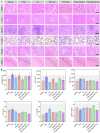Injectable electrospun fiber-hydrogel composite sequentially releasing clonidine and ropivacaine for prolonged and walking regional analgesia
- PMID: 35836801
- PMCID: PMC9274753
- DOI: 10.7150/thno.74845
Injectable electrospun fiber-hydrogel composite sequentially releasing clonidine and ropivacaine for prolonged and walking regional analgesia
Abstract
Rationale: Peripheral nerve block is a traditional perioperative analgesic method for its precise pain control and low systemic toxicity. However, a single low dose of local anesthetic merely provides a few hours of analgesia, and high dose results in irreversible toxicity, whereas continuous infusion of anesthetics is expensive and complicated. Therefore, it is necessary to develop a long-acting and sensory-selective local anesthetic for safe perioperative analgesia. Methods: An injectable composite comprising ropivacaine-loaded poly (ε-caprolactone) electrospun fiber and clonidine-loaded F127 hydrogel (Fiber-Rop/Gel-Clo composite) was developed for long-acting and walking regional analgesia with barely one dose. The peripheral nerve blockade effect of the composite was evaluated in a rat sciatic nerve block model. Also, the biodegradability and biosafety of the composite was evaluated. Results: The preferentially released Clo from the hydrogel rapidly constricted the peripheral arterial vessels, reducing the blood absorption of Rop and thus enhancing the local Rop accumulation at the injection site. The subsequently sustainable release of Rop from the fiber, significantly prolonged the sciatic nerve block of rats. Remarkably, an amazing sensorimotor segregation effect was achieved, as the sensory blockade (32.0 ± 1.4 h) lasted significantly longer than the motor blockade (20.3 ± 0.9 h). Additionally, the Fiber-Rop/Gel-Clo composite presented good biodegradability and biosafety in vivo. Conclusions: Our designed Fiber-Rop/Gel-Clo composite with minimal invasion, prolonged synergistic analgesia, and strikingly sensorimotor segregation effect, posted a promising prospect for regional long-term walking analgesia in clinical treatment.
Keywords: clonidine; electrospun fiber; injectable hydrogel; long-acting regional analgesia; ropivacaine; sensorimotor separation.
© The author(s).
Conflict of interest statement
Competing Interests: The authors have declared that no competing interest exists.
Figures






Similar articles
-
Self-Healing Hydrogel Resulting from the Noncovalent Interaction between Ropivacaine and Low-Molecular-Weight Gelator Sodium Deoxycholate Achieves Stable and Endurable Local Analgesia in Vivo.ACS Appl Mater Interfaces. 2024 Sep 4;16(35):45969-45988. doi: 10.1021/acsami.4c07883. Epub 2024 Aug 22. ACS Appl Mater Interfaces. 2024. PMID: 39171973
-
Injectable Hydrogel Delivery System with High Drug Loading for Prolonging Local Anesthesia.Adv Sci (Weinh). 2024 Jun;11(24):e2309482. doi: 10.1002/advs.202309482. Epub 2024 Mar 13. Adv Sci (Weinh). 2024. PMID: 38477406 Free PMC article.
-
Local anesthetic sciatic nerve block and nerve fiber damage in diabetic rats.Reg Anesth Pain Med. 2010 Jul-Aug;35(4):343-50. doi: 10.1097/aap.0b013e3181e82df0. Reg Anesth Pain Med. 2010. PMID: 20607875
-
Clonidine as an adjuvant to local anesthetics for peripheral nerve and plexus blocks: a meta-analysis of randomized trials.Anesthesiology. 2009 Aug;111(2):406-15. doi: 10.1097/ALN.0b013e3181aae897. Anesthesiology. 2009. PMID: 19602964 Review.
-
Preliminary risk-benefit analysis of ropivacaine in labour and following surgery.Drug Saf. 1997 Jun;16(6):391-402. doi: 10.2165/00002018-199716060-00005. Drug Saf. 1997. PMID: 9241493 Review.
Cited by
-
Prolonged Anesthesia Effects of Locally Administered Ropivacaine via Electrospun Poly(caprolactone) Fibrous Membranes.Membranes (Basel). 2023 Oct 27;13(11):861. doi: 10.3390/membranes13110861. Membranes (Basel). 2023. PMID: 37999348 Free PMC article.
-
Controlled-release hydrogel loaded with magnesium-based nanoflowers synergize immunomodulation and cartilage regeneration in tendon-bone healing.Bioact Mater. 2024 Feb 28;36:62-82. doi: 10.1016/j.bioactmat.2024.02.024. eCollection 2024 Jun. Bioact Mater. 2024. PMID: 38440323 Free PMC article.
-
Postoperative Multimodal Analgesia Strategy for Enhanced Recovery After Surgery in Elderly Colorectal Cancer Patients.Pain Ther. 2024 Aug;13(4):745-766. doi: 10.1007/s40122-024-00619-0. Epub 2024 Jun 5. Pain Ther. 2024. PMID: 38836984 Free PMC article. Review.
-
A randomized trial: The safety, pharmacokinetics and preliminary pharmacodynamics of ropivacaine oil delivery depot in healthy subjects.PLoS One. 2023 Sep 19;18(9):e0291793. doi: 10.1371/journal.pone.0291793. eCollection 2023. PLoS One. 2023. PMID: 37725618 Free PMC article. Clinical Trial.
-
Emerging advances in drug delivery systems (DDSs) for optimizing cancer complications.Mater Today Bio. 2024 Dec 5;30:101375. doi: 10.1016/j.mtbio.2024.101375. eCollection 2025 Feb. Mater Today Bio. 2024. PMID: 39759851 Free PMC article. Review.
References
-
- Kehlet H. Postoperative pain, analgesia, and recovery-bedfellows that cannot be ignored. Pain. 2018;159(Suppl 1):S11–S16. - PubMed
-
- Rawal N. Current issues in postoperative pain management. Eur J Anaesthesiol. 2016;33:160–171. - PubMed
-
- Memtsoudis SG, Cozowicz C, Bekeris J, Bekere D, Liu J, Soffin EM. et al. Peripheral nerve block anesthesia/analgesia for patients undergoing primary hip and knee arthroplasty: Recommendations from the international consensus on anesthesia-related outcomes after surgery (icaros) group based on a systematic review and meta-analysis of current literature. Reg Anesth Pain Med. 2021;46:971–985. - PubMed
-
- Petrini FM, Bumbasirevic M, Valle G, Ilic V, Mijović P, Čvančara P. et al. Sensory feedback restoration in leg amputees improves walking speed, metabolic cost and phantom pain. Nat Med. 2019;25:1356–1363. - PubMed
-
- Leone S, Di Cianni S, Casati A, Fanelli G. Pharmacology, toxicology, and clinical use of new long acting local anesthetics, ropivacaine and levobupivacaine. Acta Biomed. 2008;79:92–105. - PubMed
Publication types
MeSH terms
Substances
LinkOut - more resources
Full Text Sources

